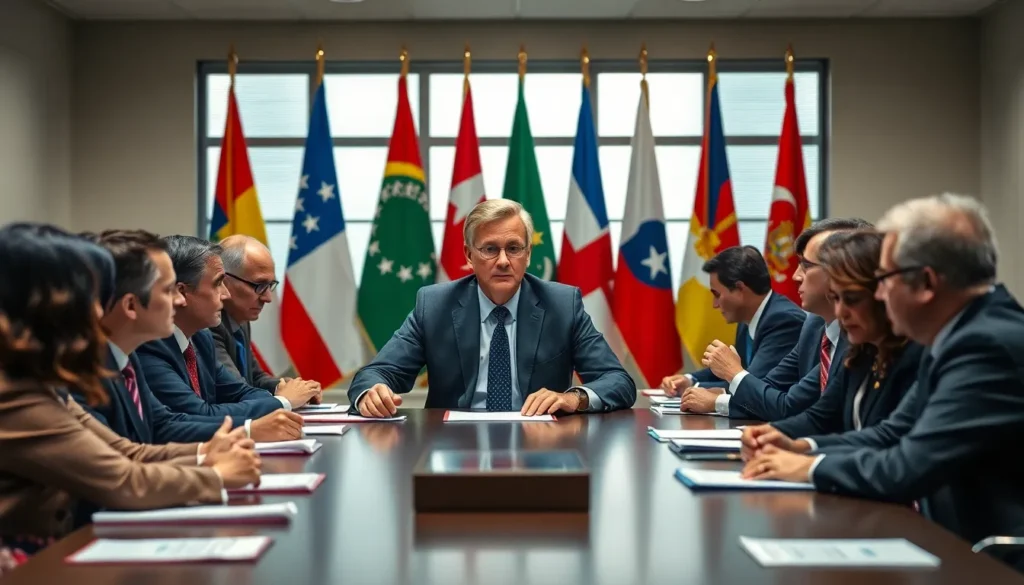Table of Contents
ToggleIn a world where diplomacy often feels like a game of chess played by toddlers, keeping up with foreign policy updates is more crucial than ever. Whether it’s trade deals that sound like they were cooked up in a sitcom writers’ room or international summits that resemble family reunions gone awry, these updates shape our global landscape in ways that can be both baffling and fascinating.
As nations navigate through alliances and rivalries, understanding the latest shifts can feel like trying to decode hieroglyphics. But fear not! This article dives into the latest foreign policy developments, breaking them down into digestible bites. Get ready to chuckle, learn, and maybe even impress your friends with your newfound knowledge of the diplomatic dance happening right under our noses.
Overview of Recent Foreign Policy Updates
Recent developments in foreign policy reflect shifting global dynamics and emphasize the importance of engagement. The United States has enhanced diplomatic relations with several nations, focusing on trade agreements and security partnerships. Notably, the U.S. and the European Union concluded discussions on tariffs, aiming for mutual economic benefits.
Additionally, diplomatic efforts between the U.S. and China continue, addressing issues like climate change and technology competition. Talks surrounding tariffs on goods have generated both tension and collaboration, shaping future economic interactions.
The Middle East remains a focal point with ongoing dialogues centered on security and peace. Countries in the region have engaged in discussions to stabilize relationships and address humanitarian concerns. Recent agreements between Israel and its neighboring states illustrate a commitment to fostering regional peace.
Africa has also gained attention, with the U.S. increasing its presence through diplomatic missions and economic investments. Enhanced partnerships in areas such as health and infrastructure signal a strategic approach to countering global challenges.
Russia’s actions in Eastern Europe prompt ongoing analysis. The international community closely monitors its military movements and electoral interference, necessitating dialogue to address security concerns.
As these updates unfold, the emphasis on multilateralism and collaboration will shape the international landscape. Tracking these shifts informs individuals and organizations about the implications these policies may impose on global relations.
Key Global Players

Key global players significantly shape foreign policies and international relations. Understanding their dynamics aids in comprehending the current geopolitical landscape.
United States
The United States strengthens its relationships through strategic trade agreements. Recent discussions with the European Union on tariffs aim to create economic synergy. Diplomatic efforts also extend to addressing climate change and technological competition with China. Increased presence in Africa marks a notable shift, reflecting an investment in diplomatic missions and economic development. Collaborative initiatives underscore the U.S. commitment to fostering global partnerships, enhancing stability in various regions.
China
China continues to assert its influence through extensive trade networks and economic initiatives. Engagements with the United States focus on critical areas such as climate policies and technology resources. Partnerships with countries in Asia and Africa reveal China’s strategy of expanding its global footprint. The Belt and Road Initiative exemplifies China’s push for infrastructure and investment in developing nations. Navigating these relationships, China emphasizes its status in global economics and diplomacy, shaping future international dialogue.
Russia
Russia’s assertive actions in Eastern Europe remain a focal point for global analysis. Military movements in Ukraine and involvement in regional conflicts provoke scrutiny from Western nations. Ongoing discussions around electoral interference highlight Russia’s contentious stance on democratic processes. Diplomatic isolation paired with increased military presence suggests a complex geopolitical strategy. Observations of Russia’s engagement provide insights into its foreign policy and intentions toward neighboring countries, emphasizing the need for vigilance from the international community.
Regional Focus
Recent updates in foreign policy emphasize the evolving dynamics across various regions. Key areas include the Middle East and the Asia-Pacific, where significant developments are unfolding.
Middle East Developments
Israel’s agreements with neighboring states showcase a strong commitment to regional stability. Ongoing dialogues focus on security cooperation and economic collaboration, directly addressing mutual concerns. Continued U.S. support remains crucial, facilitating peace talks and ensuring that stakeholders pursue diplomatic solutions. Moreover, the influence of Iran persists, creating challenges for peace efforts. Efforts to counter Iranian activities are evident in military partnerships and intelligence-sharing initiatives among allied nations.
Asia-Pacific Dynamics
China’s influence continues to expand throughout the Asia-Pacific region. The Belt and Road Initiative drives infrastructure projects, fostering economic partnerships with numerous countries. Efforts to strengthen ties with Southeast Asian nations highlight the importance of regional trade agreements. Geopolitical tensions with Taiwan and ongoing maritime disputes in the South China Sea further complicate relationships among regional players. The United States maintains its presence through military alliances and economic engagements, reinforcing commitments to partner nations while addressing strategic interests in the area.
Impact on International Relations
Foreign policy updates significantly influence international relations, impacting diplomacy and cooperation among nations. Recent developments emphasize collaboration and strategic partnerships.
Economic Implications
Economic relationships shape global interactions. The U.S. and the European Union’s recent tariff discussions aim for mutual economic benefits, enhancing trade opportunities. Increased engagement with African nations showcases the U.S. commitment to economic partnerships in emerging markets. China’s Belt and Road Initiative further indicates the role of expansive trade networks, fostering strong economic ties. Collaboration on economic policies and trade agreements drives growth while addressing mutual interests.
Security Concerns
Security remains a paramount concern in international relations. Ongoing dialogues between the U.S. and China focus on military readiness, reflecting geopolitical tensions. Mobilization of Russian troops in Eastern Europe raises alarms, leading to heightened surveillance and strategic responses from NATO allies. In the Middle East, Israel’s agreements with neighboring states underscore efforts toward regional stability, particularly amid concerns regarding Iranian influence. Strengthened military partnerships facilitate intelligence sharing and enhance collective security measures globally.
Staying updated on foreign policy developments is essential in today’s interconnected world. As global dynamics shift and relationships evolve, understanding these changes allows individuals to grasp their implications on international relations.
The ongoing dialogues and agreements between nations reflect a commitment to collaboration and stability. By engaging with these updates, readers can better navigate the complexities of global affairs. Knowledge is power, and sharing insights can foster informed discussions within communities. As the landscape continues to change, staying informed will remain crucial for everyone interested in the world stage.







